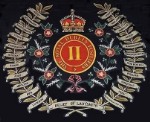The British Army in the Long 19th Century
The "Long 19th Century" covers the period of time from the French Revolution (1789) to the outbreak of the First World War (1914). For this website, that time period is truncated; here it begins after the end of the Napoleonic Wars (1815). The fictional Brian Tweedy of Ulysses became a soldier in 1853 and retired from the army in late 1885 or early 1886, and of course June 16, 1904, is the first Bloomsday. Accordingly, the British Army material on this website is for the period 1850 through 1904 (Mid-Victorian, Late-Victorian, and Edwardian Eras).
Pages on Major Tweedy's Neighborhood
Here you will find material on the British Army, 1850 through 1910. This material is related to the Ireland and Dublin of 1904, Brian Tweedy's Mid-Victorian army, or the Late-Victorian/Edwardian army of Privates Compton and Carr (who appear several times in Ulysses). Note that at the time, the only major powers with wholly volunteer armed forces were the United Kingdom and the United States. All others, and most minor powers, had compulsory military service that required one to three of full-time military service (primarily for training) followed by ten to twenty years as an army reservist.
Download from Major Tweedy's Neighborhood
All these documents are in .pdf files. To download the file, click on the document link. The document will open in a new browser window.
British Army Annual General Report, September 1906
Parliamentary Papers, 1907 (Vol. 9), [Cd. 3365]. The last report on the British Army of the Long Nineteenth Century. In December 1905, Campbell-Bannerman, head of the minority Liberal government, appointed Richard Haldane Secretary of State for War. The next year, Haldane began the reforms that bear his name. The Haldane Reforms, the most important of which were implemented in 1908 under the Territorial and Reserve Forces Act 1907, created the 20th Century British Army.
Cover and Contents (01_Cover_Contents.pdf, 1.1 MB)
Section I
Annual Recruiting Report (02_Recruiting.pdf, 12.1 MB)Section II
Parts 1 - 3 (03_Tables_1-3.pdf, 9.8 MB)Parts 4 - 7 (04_Tables_4-7.pdf, 7.8 MB)Parts 8 - 13 (05_Tables_8-13.pdf, 10.1 MB)
Recruiting pamphlet published by the War Office. Handed out by recruiting sergeants and available at all post offices. Transcribed from Parliamentary Papers, 1898 (Vol. 54), No. 81. Army_Pamphlet_1898.pdf, 285 kb.
This book was issued to each enlisted man to provide him "with (1) certain information which he will find useful to him during his service, and (2) a record of his service in the Army. ... Every entry in this book is to be made under the superintendnence of the officer commanding the squadron, troop, battery or company to which the man belongs." Among the useful information is "How to Prevent Sore Feet" at page 17. SmallBook_1903.pdf, 15.2 MB.
Army Bands: Regulations and Standing Orders
"By the stern stone hand of Grattan, bidding halt, an Inchicore tram unloaded straggling Highland soldiers of a band." U (Gabler) 10:352-53.
"Unseen brazen highland laddies blared and drumthumped after the cortege." U (Gabler) 10:1249-50).
In the above lines James Joyce alludes to the 2nd/Seaforth Highlanders. On Bloomsday, that battalion was quartered in Richmond Barracks in the Inchicore neighborhood of Dublin, south of Phoenix Park. Click on the following links for the army regulations for bands and the standing orders for the bands of the Seaforth Highlanders. Bands, King's Regulations and Orders for the Army, 1908, 115 kb. , LTC E.A. Cowans and LTC D. Campbell, Standing Orders of the Seaforth Highlanders (Letchworth: 1912), 134 kb.
Recruiting pamphlet published by the War Office. Similar to the above publication but for the militia. Transcribed from Parliamentary Papers, 1898 (Vol. 54), No. 81. Militia_Pamphlet_1898.pdf, 183 kb.
Three pages: Attestation, Description of Man on Enlistment, and Statement of Services. MilitiaEnlist1900.pdf 2.5 MB.
Links to Other Websites
Note: The webpages will open in new windows.
Click on the link to go to that page of the website. Click on the icon to go to the website's home page.
From The Victorian Web, "one of the oldest academic and scholarly websites. Originally begun back in 1987 as a means of helping scholars and students to see connections between different fields, the site today has greatly expanded the kinds of connections one can find. The site now receives 1.5 million page views a month." Material lent to the website and images from museums, commercial galleries, and owners generally may not be used for commercial purposes. See website's terms of use.
From The British Empire, a website of Stephen Luscombe, a former secondary school teacher. Unlike the above-referenced Victorian Web, the website is "not a rigorous academic site." Though a proprietary interest in images is not claimed by Luscombe, many, if not most, are property of third-parties.
Documents on Other Websites
All these documents are in .pdf files and are fully readable. To download the file click on the document name or its website icon. The file will open from the other website in a new browser window. See Download Instructions if you're unfamiliar with the website.
Parliamentary Papers, 1884-855, Vol. 46, [C. 4570]. From the Hathi Trust. Report begins at Page 101 of the digitized document. Hathi Partner login required to download the full document.
From Google Books. All can download the full document.
From the Hathi Trust. Hathi Partner login required to download the full document.
From Google Books. All can download the full document.
From the Internet Archive. All can download the full document.
From Google Books. All can download the full document.
From the Hathi Trust. Hathi Partner login required to download the full document.
From the Hathi Trust. Hathi Partner login required to download the full document.
